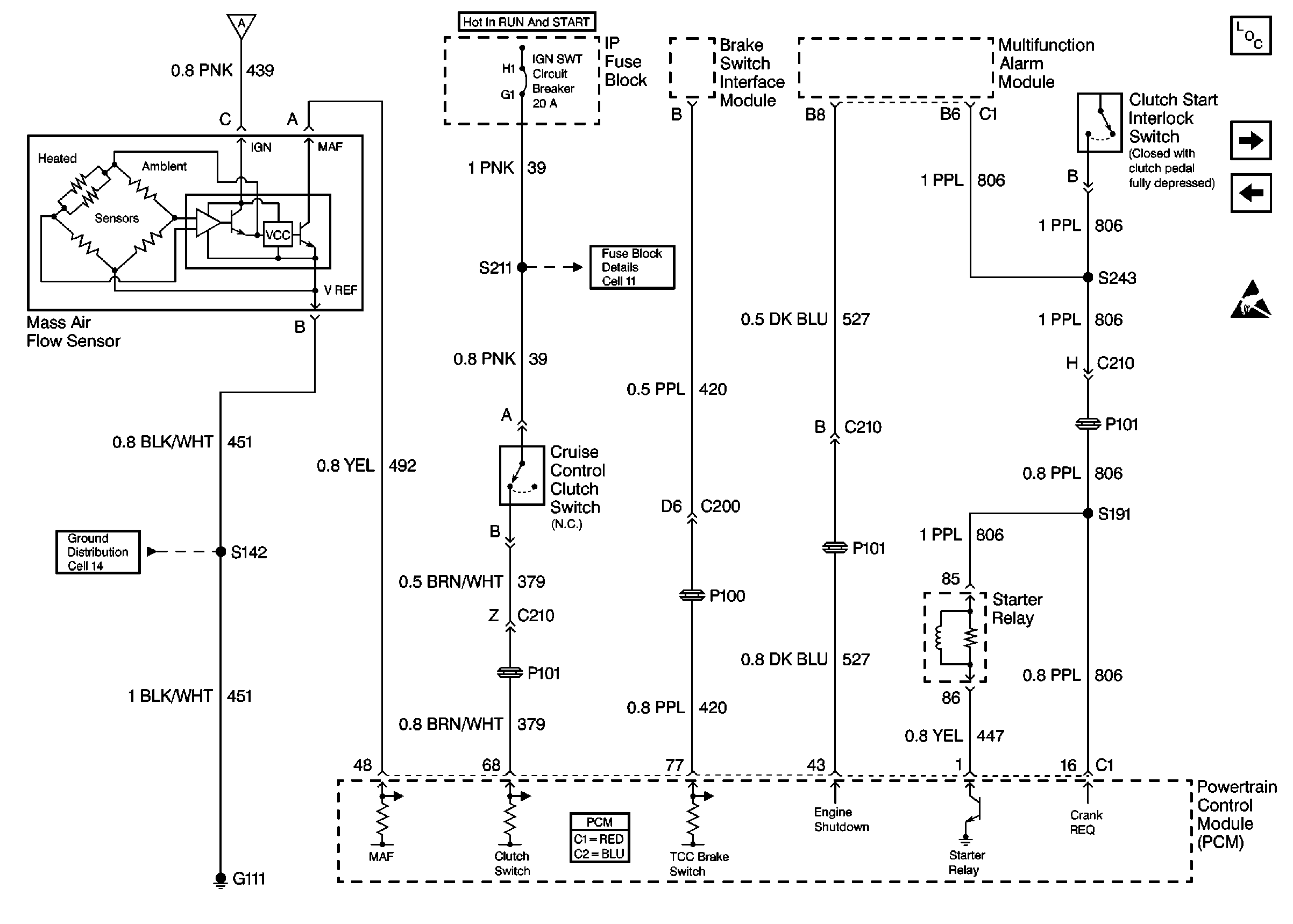Refer to
Cell 20: Mass Air Flow Sensor, Clutch Pedal Position Switch, Starter
Relay

Circuit Description
The clutch switch is a normally closed switch (clutch pedal released). The PCM detects an ignition voltage on the clutch switch circuit when the clutch switch is closed. The PCM detects 0 volts on the clutch switch circuit when the clutch switch is open (clutch pedal depressed).
This DTC determines if the Transmission Clutch switch has failed by looking for a clutch switch transition during a predetermined drive cycle.
Conditions for Running the DTC
No VSS DTCs.
Conditions for Setting the DTC
| • | The vehicle speed goes from 0 mph to greater than 24 mph and back to 0 mph for 2 seconds without the PCM detecting a clutch transition. |
| • | This must occur 4 times before the diagnostic reports a fault. |
Action Taken When the DTC Sets
| • | The PCM stores the DTC information into memory when the diagnostic runs and fails. |
| • | The Malfunction Indicator Lamp (MIL) will not illuminate. |
| • | The PCM records the operating conditions at the time the diagnostic fails. The PCM stores this information in the Failure Records. |
Conditions for Clearing the MIL/DTC
| • | A last test failed (current DTC) clears when the diagnostic runs and does not fail. |
| • | A History DTC clears after forty consecutive warm-up cycles, if this or any other emission related diagnostic does not report any failures. |
| • | Use a scan tool in order to clear the MIL/DTC. |
Diagnostic Aids
Important: Remove any debris from the PCM\TAC module connector surfaces before servicing the PCM\TAC module. Inspect the PCM\TAC module connector gaskets when diagnosing/replacing the modules. Ensure that the gaskets are installed correctly. The gaskets prevent water intrusion into the PCM\TAC modules.
The following may cause an intermittent:
| • | Check for poor connections. Check for adequate terminal tension. Refer to Wiring Repairs Wiring Systems for proper procedure. |
| • | Corrosion |
| • | Mis-routed harness |
| • | Rubbed through wire insulation |
| • | Broken wire inside the insulation |
Using Freeze Frame and/or Failure Records data may aid in locating an intermittent condition. If you cannot duplicate the DTC, the information included in the Freeze Frame and/or Failure Records data can aid in determining how many miles since the DTC set. The Fail Counter and Pass Counter can also aid determining how many ignition cycles the diagnostic reported a pass and/or a fail. Operate the vehicle within the same freeze frame conditions (RPM, load, vehicle speed, temperature etc.) that you observed. This will isolate when the DTC failed. For an intermittent, refer to Lack of Power, Sluggishness, or Sponginess .
Test Description
The numbers below refer to the step numbers on the diagnostic table.
Step | Action | Value(s) | Yes | No |
|---|---|---|---|---|
1 | Did you perform the Powertrain On-Board Diagnostic (OBD) System Check? | -- | ||
Does the scan tool display change states when the clutch is depressed and released? | -- | Go to Diagnostic Aids | ||
3 |
Does the scan tool display the Clutch Switch Released? | -- | ||
4 | Remove the jumper. Does the scan tool display the Clutch Switch Depressed? | -- | ||
5 | Probe the clutch switch ignition feed circuit with a test lamp connected to a ground. Is the test lamp illuminated? | -- | ||
6 | Check for a short to B+ on the clutch switch signal circuit. Refer to Wiring Repairs in Wiring Systems. Did you find and repair the condition? | -- | ||
7 | Check for poor terminal contact for the clutch switch signal circuit at the clutch switch connector. Refer to Wiring Repairs in Wiring Systems. Did you find and repair the condition? | -- | ||
8 | Check for an open in the clutch switch signal circuit. Refer to Wiring Repairs in Wiring Systems. Did you find and repair the condition? | -- | ||
9 | Repair the open in the clutch switch ignition feed circuit. Refer to Wiring Repairs in Wiring Systems. Is the action complete? | -- | -- | |
10 | Replace the clutch switch. Is the action complete? | -- | -- | |
11 | Check the terminal tension at the PCM connector for the clutch switch signal circuit. Refer to Wiring Repairs in Wiring Systems. Did you find and repair the condition? | -- | ||
12 |
Important:: Program the replacement PCM. Refer to Powertrain Control Module Replacement/Programming . Replace the PCM. Is the action complete? | -- | -- | |
13 |
Does the scan tool indicate that this test ran and passed? | -- | ||
14 | Select the Capture Info option and the Review Info option using the scan tool. Are any DTCs displayed that you have not diagnosed? | -- | Go to Applicable DTC Table | System OK |
